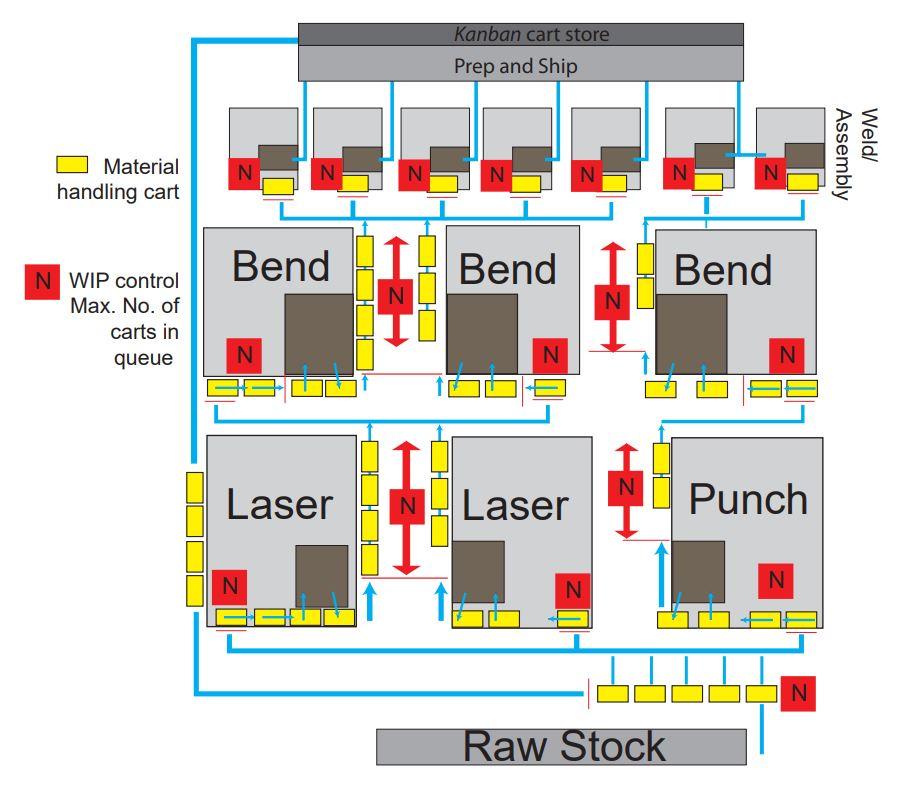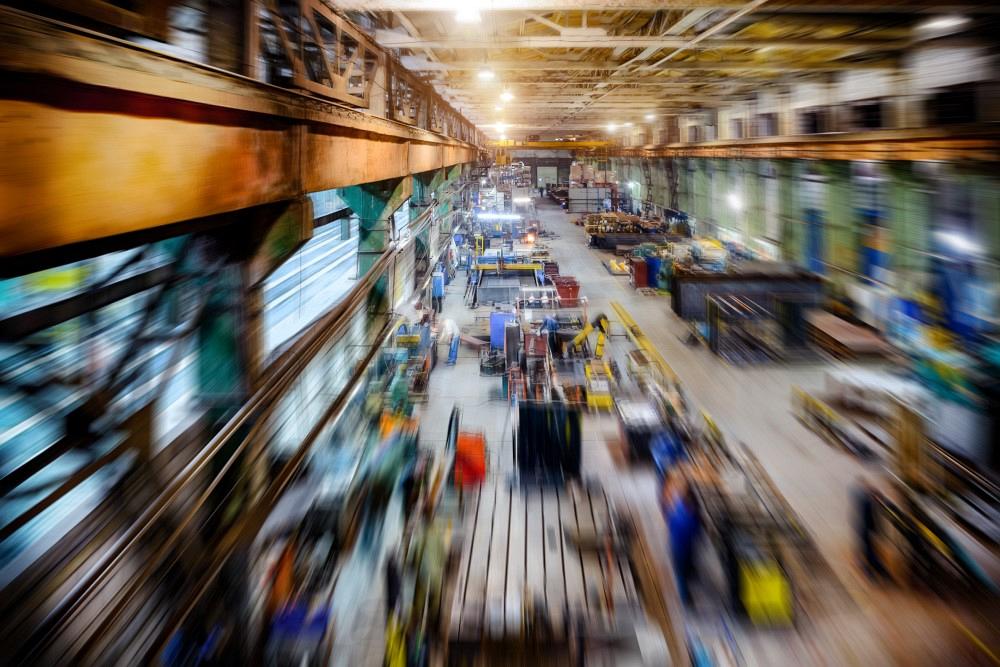Senior Editor
- FMA
- The Fabricator
- FABTECH
- Canadian Metalworking
Categories
- Additive Manufacturing
- Aluminum Welding
- Arc Welding
- Assembly and Joining
- Automation and Robotics
- Bending and Forming
- Consumables
- Cutting and Weld Prep
- Electric Vehicles
- En Español
- Finishing
- Hydroforming
- Laser Cutting
- Laser Welding
- Machining
- Manufacturing Software
- Materials Handling
- Metals/Materials
- Oxyfuel Cutting
- Plasma Cutting
- Power Tools
- Punching and Other Holemaking
- Roll Forming
- Safety
- Sawing
- Shearing
- Shop Management
- Testing and Measuring
- Tube and Pipe Fabrication
- Tube and Pipe Production
- Waterjet Cutting
Industry Directory
Webcasts
Podcasts
FAB 40
Advertise
Subscribe
Account Login
Search
Finding flow in custom metal fabrication with an efficient shop floor layout
Reliable delivery in manufacturing comes from predictable part flow
- By Tim Heston
- August 25, 2022
- Article
- Shop Management
Almost a decade ago during a lean manufacturing seminar hosted by the Fabricators & Manufacturers Association, the late Dick Kallage, longtime industry consultant, pointed to a proposed shop layout. It had a simple elegance to it: just a row of lasers and punches feeding a row of press brakes, followed by a row of welding and assembly cells. I recall Kallage saying, “Is there really a reason this wouldn’t work?”
He proposed removing all the shelves of work-in-process (WIP) near work centers. All WIP would be placed on carts, and only a certain number would be allowed between processes. What made this practical, Kallage said, was streamlined changeovers, well-maintained machinery, good purchasing practices (such as good sheet metal that behaves predictably when cut, formed, and welded), good operator training, and documented processes—all aiming to minimize rework, arguably the most expensive kind of waste a custom fab shop can produce.
This shop layout could still apply today. Sure, inventory buffers might need to be adjusted for supply chain issues, and there might be complications when it comes to certain secondary processes like deburring. If transporting large workpieces, the operation might need to replace carts with pallets or Kanban squares. And depending on its part mix and the nature of its work, a shop also might need some racking to accommodate a limited number of filler parts (to optimize material utilization in nesting). Still, the bones are solid. The layout could be seen as a kind of building block, a module that could be duplicated and adapted as a shop grows.
Imagine you’re launching a fabricator today and decide to lay out your small shop like this—but unlike entrepreneurs of previous generations, you also make full use of software from the get-go. Software also helps streamline the front end, revealing issues early, allowing people to solve them before a job reaches the floor. Software investment boosts efficiency in order processing and, thanks to machine monitoring and order tracking, reveals true capacity levels at every work center.
From here, you could scale up by either growing the current layout or duplicating it as another “fabrication module” and dedicating it to a certain range of part geometries or products. Raw stock shelves turn into automated storage and retrieval towers. WIP gets handled by a combination of carts, automated guided vehicles, or perhaps even mobile robots. All this automation might boost throughput, but more than anything else, it reduces variability as the shop grows, mitigating reliance on an army of manual labor that today, well, just doesn’t exist.
The predictability of automation also ensures the constraint process is (at least ideally) never starved of work. Constraints move all the time in the job shop, of course. But in recent years, technology in press brakes, panel bending and folding, punching, laser cutting, and even laser welding has eliminated many of those one-time bottlenecks. Still, some manufacturing technologies, like heat treating or powder coating, are batch processes by nature. Powder coated parts need to be masked, and they need time to cure. Regardless, the predictable capacity upstream, within those fabrication modules, ensures those remaining constraints never wait for work.
Because constraints are never starved, a fabricator knows when the floor is at maximum capacity. As the shop grows to become a larger contract fabrication operation, it might add more fabrication modules in a dedicated facility to create a kind of “component factory” that feeds upper-level assembly operations downstream, either within the same plant or at other facilities.
Every detail behind Kallage’s flow concept won’t apply everywhere, but it might be an inspiration. Consider the concept an ideal worth striving for. Not every job has the same level of variability, especially when it comes to manual processes. A welder or assembler on first shift might be more productive than welders on second or third shift. So, in this case, WIP buffers might need to be larger.
The idea is to reduce that variability with a combination of training, sharing of best practices, and automation. The predictability of automation, not necessarily its speed, is the primary draw. Part-removal automation in punching or laser cutting might seem sluggish—a team of denesters could probably handle some jobs faster. But denesters get tired. They might route a specific part downstream incorrectly. Chaos rises, rework ensues, profits plummet, and flow becomes hard to predict.
And when you get right down to it, this business is all about flow. Even the smallest shops will likely be more successful after improving it. After all, a job doesn’t make money until it ships.

This flow concept, presented by the late Dick Kallage at an FMA lean manufacturing conference nearly a decade ago, still applies today. As shown, limits on the number of carts minimizes work-in-process. The concept could be adapted for different shop layouts, processes, and material handling methods.
About the Author

Tim Heston
2135 Point Blvd
Elgin, IL 60123
815-381-1314
Tim Heston, The Fabricator's senior editor, has covered the metal fabrication industry since 1998, starting his career at the American Welding Society's Welding Journal. Since then he has covered the full range of metal fabrication processes, from stamping, bending, and cutting to grinding and polishing. He joined The Fabricator's staff in October 2007.
Related Companies
subscribe now

The Fabricator is North America's leading magazine for the metal forming and fabricating industry. The magazine delivers the news, technical articles, and case histories that enable fabricators to do their jobs more efficiently. The Fabricator has served the industry since 1970.
start your free subscription- Stay connected from anywhere

Easily access valuable industry resources now with full access to the digital edition of The Fabricator.

Easily access valuable industry resources now with full access to the digital edition of The Welder.

Easily access valuable industry resources now with full access to the digital edition of The Tube and Pipe Journal.
- Podcasting
- Podcast:
- The Fabricator Podcast
- Published:
- 04/16/2024
- Running Time:
- 63:29
In this episode of The Fabricator Podcast, Caleb Chamberlain, co-founder and CEO of OSH Cut, discusses his company’s...
- Trending Articles
AI, machine learning, and the future of metal fabrication

Employee ownership: The best way to ensure engagement

Steel industry reacts to Nucor’s new weekly published HRC price

Dynamic Metal blossoms with each passing year

Metal fabrication management: A guide for new supervisors

- Industry Events
16th Annual Safety Conference
- April 30 - May 1, 2024
- Elgin,
Pipe and Tube Conference
- May 21 - 22, 2024
- Omaha, NE
World-Class Roll Forming Workshop
- June 5 - 6, 2024
- Louisville, KY
Advanced Laser Application Workshop
- June 25 - 27, 2024
- Novi, MI



























